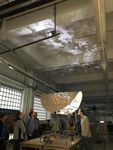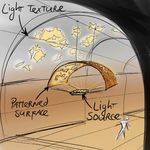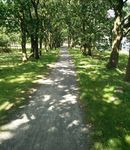Light & Shadow: A chandelier as a walk through the forest
←
→
Page content transcription
If your browser does not render page correctly, please read the page content below
Light & Shadow:
A chandelier as a
walk through the
forest
Design by Wim aan de Stegge
Text by Pieter Desmet
Light in the darkness
On New Year’s Eve 1813, Londoners witnessed an
historic event. That very evening, the state-of-the-art
gas lighting of Westminster Bridge was first lit. New
ground had been broken, with light in the city at night!
This momentous occasion was to be the launchpad
of a structural transformation in the appearance
of urban areas. By 1900, gas lighting had reached
almost every city in Europe and North America. How-
ever, even faster than its emergence, the gas light
disappeared again from our streets and houses. The
reason for this no secret: the invention of the cheaper
and safer electric light. Nowadays, we can no longer
imagine life without the omnipresent cheap, safe and
effective light that comes from electricity.
Light and Shadow Design
Conventionally, a lighting designer begins with the
following question: how can I create the best possible
light quality given the possibilities of the light source?
However, with the evolution of modern LED technology,
these possibilities are now infinite. Virtually any colour
2 2The Biophilic Chandelier
Wim designed a chandelier for the Hoge Veluwe
Park Pavilion in Otterlo. The chandelier projects
Biophilic Design
a dynamic light texture onto the vaulted ceiling
Social ecologist Stephen Kellert (2008) trans- of the visitor centre. The chandelier combines a
lated the biophilia hypothesis into a series of powerful LED matrix as a light source with a curved
design principles: biophilic design with the aim of surface that has been laser-cut into a pattern.
Light textures in nature
strengthening man’s connection with his natural Dynamic lighting effects are created by means
environment. Wim was inspired by the two core of video material from the natural environment.
and light effect can be created, including move- ments. Biophilia is stroking the cat, walking bare-
principles: naturalism and place-attachment. Nat- The light texture connects the architecture with
ment and other forms of dynamic expression. Even foot in the grass, an office overlooking the park,
uralism is the integration of natural elements in the surrounding nature park. The play of light and
shadows are no longer just a side effect of lighting; and flowers in the house. Fulfilling this need has
man-made designs. This may either be direct (with shadow gives the experience of walking on a forest
in dynamic light textures they are an integral part
many positive effects on well-being. For example,
daylight or views of natural elements), indirect path with the foliage of the trees as a vaulted ceil-
of the design. This fact inspired designer Wim aan
the presence of plants in hospitals has been shown
de Stegge to develop a wellbeing-driven lighting (with cultivated nature such as pot plants) or sym- ing. Wim deliberately chose an abstracted pattern.
to reduce depression and pain in patients, improve
design. The result is a chandelier that makes a so- bolic (with representations or images of nature). It is therefore not a literal projection of foliage but a
mood, and accelerate recovery (for an overview,
phisticated connection between the building and Place-attachment is the connection between symbolic representation. This makes branches and
its surroundings. (Aan de Stegge, 2020). see Soderlund & Newman, 2015).
the built environment and the local ecology; the leaves recognisable, but at the same time the light
relationship between a building, mankind, and the also enters into a logical relationship with man-
Nature as a Human Necessity
environment. made architecture.
The American biologist Edward Wilson introduced
the idea that people have an innate connection
with the natural environment (Wilson, 1984). He
launched the “biophilia hypothesis”: the inherent
human need for life forms and other natural ele-
Design sketch and prototype The Design Integrated in the Hoge Veluwe Park Pavilion (photos by Stijn Bollaert)
3 4In 2020, Wim aan de Stegge (photo) researched the concept of biophilic
light patterns as a thesis project for his Integrated Product Design mas-
ter’s degree. He conducted his initial research in association with Signify.
He applied insights from this research to Beersnielsen Lichtontwerpers’
chandeliers for the Hoge Veluwe Park Pavilion (Otterlo). The supervisors
were Sylvia Pont and Erik Jepma (TU Delft), Laura Taylor (Signify) and Sjo-
erd van Beers (Beersnielsen). The design won a DARC and LIT lighting
design award in 2019. Wim is currently working as a lighting designer at
Mandala, a lighting design studio in New Delhi. Thanks to Beersnielsen for
providing the photographs of Stijn Bollaert.
References
Aan de Stegge, W. (2020). Biophilic light Texture: Applying biophilic design principles to lighting design (Master
thesis, TU Delft).
Kellert, S.R., Heerwagen, J.H., & Mador, M.L. (2008). Biophilic design: The theory, science, and practice of bringing
buildings to life. Hoboken: Wiley.
Soderlund, J., & Newman, P. (2015). Biophilic architecture: a review of the rationale and outcomes. AIMS environ-
mental science, 2(4), 950-969.
Wilson, E.O. (1984). Biophilia. Massachusetts: Harvard University Press.
The Design Integrated in the Hoge Veluwe Park Pavilion (photos by Stijn Bollaert)
Science and Intuition a convincing form of poetic technology. Two centu-
ries ago, the revolutionary gas lighting of Westmin-
For Wim, the project was a personal quest for
ster Bridge represented a victory for mankind over
a good balance between knowledge- and intu-
the limitations of nature. The biophilic chandelier
ition-driven design: “As a designer, especially in
embodies a new significance for lighting: light as a
the field of lighting, I have to embrace my intuition.
connection between the artificial and the natural.
That is not to say that science has no value in my
And so light and shadow have definitively gained a
design process, quite the contrary! However, reality
firm foothold in the positive designer’s repertoire.
can never be completely captured by the rules of a
scientific model, and where science ends, I have to
use my intuition”. With this combination, he created
5 6Colophon
Light & Shadow: A chandelier as a walk through the forest
2020
Faculty of Industrial Design Engineering
Delft University of Technology
The Netherlands
Product concept & design by Wim aan de Stegge
Text by Pieter Desmet
Photographs by Wim aan de Stegge and Stijn Bollaert
Graphic design by Matthijs de Koning
Copyright © 2020 by Pieter Desmet and Wim aan de Steg-
ge. All rights reserved. This article or any portion thereof may
not be reproduced or used in any manner without written
permission of the copyright holders.
This article was originally written for the Dutch Journal of
Positive Psychology (www.tijdschriftpositievepsychologie.nl).
All articles from the series can be downloaded at www.diopd.
org
Reference
Desmet, P.M.A. (2020). Light and Shadow: A chandelier as a
walk through the forest. Delft, Delft University of Technology.
7You can also read
























































